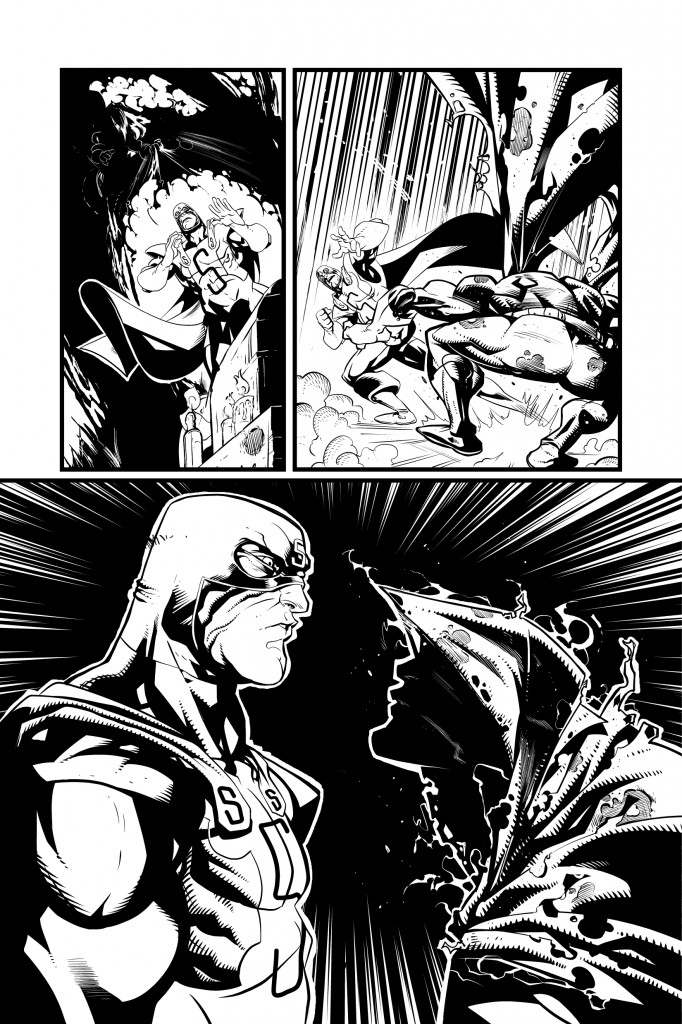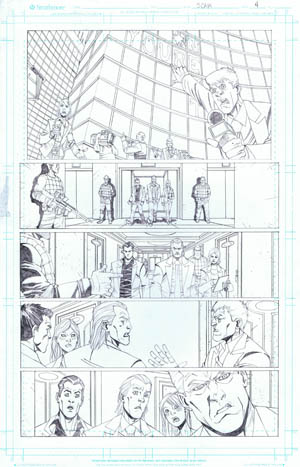Prioritize Your Creative Time
In any given week, my long ComixTribe To-Do List might look something like this:
- Pack and ship a half-dozen Shop.ComixTribe.com orders.
- Request a print quote for a future ComixTribe book.
- Strategize with a CT creator on promoting an upcoming release.
- Order office, shipping, and mailing supplies.
- Check inventory for an upcoming convention.
- Read and respond to e-mails from creators pitching CT books and projects.
- Format complete or nearly complete pages, readying them for print.
- Updating the ComixTribe.com site.
- Updating Shop.ComixTribe.com with our latest books for pre-orders.
- Tracking and updating the ComixTribe books, to keep financial records up to date.
- Do budgets for current and potential projects.
- Write and send out press releases to comics media, reviewers, our fans, and retailers.
I could go on, but that’ll give you an idea of the kinds of things that fill up my ComixTribe time. Three quick observations about the above list:
1) Everything listed is an important component of running a small-press, creator owned enterprise like ComixTribe.
2) Very little on the list above requires the exhaustion of creative muscle…rather most of the things on the list are rather straightforward administrative tasks.
3) I did not get into comics to load up my schedule with more administrative tasks.
And yet, in my role as ComixTribe publisher, I could EASILY fill every minute of the 35-50 hours a week I have available for ComixTribe doing non-creative tasks. And while there is nothing sexy about the stuff on the above to-do list…they DO have strong appeal– namely that they are easy to complete.
Like many creators (and MOST who work in creator-owned), comics is my five-to-nine job, while I work a nine-to-five in another field. My “day job” is similar to comics in that it combines both the creative (game design) and the administrative (game production), and like my ComixTribe work, it always seems there is not enough time in the day to get it all done.

THE STANDARD #4 art by Jonathan Rector
After a full-day of work, like many of you, I’m exhausted, both mentally and sometimes physically…especially if I’ve either A) had a hard workout that morning or B) Let my gym schedule slip, and NOT worked out in a while. Still, I know I need to get some ComixTribe work done, so I’ll put in a few hours after dinner.
And that’s when those administrative tasks really start looking good. I don’t have the creative energy to figure out a tough plot point, write great dialog, or tackle a blank page of sequentials. But sending a few emails? Shipping a few books? Putzing around on the ComixTribe site, tweaking a widget or a sidebar? Sure, I can do that! These are relatively easy, low-brainpower tasks, that still give me the sense that I’m being productive, and allow me to cross stuff off the to-do list, like a good little publisher.
But the problem with those tasks, and this strategy in general, is that I’m leaving very little room for the most important aspect of being a comic creator…namely, being CREATIVE.
Of course, this affects a lot of us in comics, especially those of us who haven’t yet been able to make the jump to becoming a full-time creator. Jon Rector, the super talented artist of THE STANDARD, sent out an email to a bunch of ComixTribers asking for ideas on how he could possibly improve production output. Jon wrote:
“I’m seriously stressing out. Time after time, deadlines after deadlines, I can’t hit ’em. Things are looking really grim. And I honestly have no idea how to remedy this. Seriously guys, if anyone has any advice, words of encouragement, tricks….I’ll take ’em. Sitting down and working isn’t the problem. It’s finding the time to do so. I’ve cleared my plate, so this is the only project I’m working on.”
Now, Jon’s a hard worker, and has incredible attention to detail on the page. And his work on next issue of THE STANDARD will be some of the finest artwork ComixTribe has published to date. But Jon was really struggling with finding the time to actually get the pages done at a pace needed to stay relevant in comics, trying to balance it with a day job and actually having a life.
Advice came in from a number of us, with a few creators offering some tips on things that work for them:
Advice from Writer John Lees (THE STANDARD, And Then Emily Was Gone)
“It’s easy for me to say some motivational fluff like “Set your goals for the day and hit your targets!” But I’m not the one coming from from a full-day shift at work to start work on drawing a page. All I can suggest is stuff I try with my writing when I’m lagging and I want to make myself get something done. It can be helpful to set smaller, more concrete targets to get something done.
For example, rather than saying “I have the whole night to do this page” and you end up trying to will yourself to get started while on Facebook or whatever, you say “I’m gonna work on this page from 7pm to 10pm”, and let’s say you get from work around5:30, you have an hour and a half to eat, browse Facebook, get it all out of your system before cutting yourself off from internet. Then you’re putting in a shorter concentrated stint of just doing art, and wherever you are, you stop at 10. The stopping is important too, as it means it’s not something hazy that drags on forever, you have an endpoint you have to work until in sight. Then it’s like you’ve done a shift at work or something, and you can say “Here’s what I did in that time.” Then take a break, go back on Facebook and Twitter for an hour or so, maybe do another late night shift later on if you feel up to it. Compartmentalise between work and Internet rather than the two being a single amorphous entity.
And sometimes you might see me writing on Facebook or Twitter how much script I’ve written that day or whatever? That’s a tool where I’m stating a goal and making my progress public, because then I’m putting pressure on myself to follow through and get the work done because my Facebook friends now know what I’m supposed to be doing. Something as simple as a Facebook post saying, “On the drawing board tonight, page 24 of THE STANDARD” can drive you because now you can will have people asking “How are you getting on with that page?” rather than talking to you about other stuff.”

SCAM pencils by Joe Mulvey
Advice from Artist Joe Mulvey (SCAM)
“I have a TON going on at all times. I have a beautiful wife, a gorgeous and fun kid, work as a sales manager at an apparel shop, along with owning and operating a commercial retail building, and as of the last few weeks, have been taking care of an elderly aunt who’s no longer able to care for herself.
It’s a full plate.
But drawing comics is what I want to do for a living, so when it comes to having time at the drawing board I really try to make that time count I say compartmentalize your work. See where you spend the most time that you could possibly tighten up. The questions I’d ask are what’s holding you up? Is it layouts? Finishes? Scibbles w/Jonathan? Commissions? There’s always a something that can be streamlined.
For my part, I directed Jon to an article on Nate Simpson’s blog I read a while back. Nate had the break-out Image book Non-Player, the first issue of which came out in April of 2011 to much critical acclaim and retail success…and then, nothing. Nate, a super talented, super-detail oriented artists, admitted that finding time to work on the series along with the demands of his regular illustration work, was proving difficult.
Nate’s solution: 4 am.
Simpson writes on his blog:
“I’ve found a way to make serious progress on my book while holding down a full-time job. My stress levels have dropped dramatically, my productivity has soared, and I have more leisure time to share with my family and friends. Not only that, this technique should be sustainable even through fatherhood! It’s nuts!
 I’m finding a similar piece of advice in the new book Manage Your Day-To-Day: Build Your Routine, Find Your Focus & Sharpen Your Creative Mind. One of the key insights from this books is that creative professionals should always strive to do creative work (scripts, art, design) first, and reactive work (emails, logistics, planning, shipping, filing, etc.) second.
I’m finding a similar piece of advice in the new book Manage Your Day-To-Day: Build Your Routine, Find Your Focus & Sharpen Your Creative Mind. One of the key insights from this books is that creative professionals should always strive to do creative work (scripts, art, design) first, and reactive work (emails, logistics, planning, shipping, filing, etc.) second.- You get it out of the way first, so that no matter what happens during the rest of the day, you can feel good about the progress made on that creative project. “Creator guilt” aka the feeling you get when you know you should be writing or drawing, but you’re wiped out from a long day and just want to watch Game of Thrones and go to bed…it’s a real thing. By banging your creative drums early, you start the day off with a win.
- There are very little distractions early in the morning. New emails aren’t coming through. The phone isn’t ringing. Twitter is quiet. The kids aren’t crying. The wife/girlfriend isn’t resenting you for not keeping her company. In short, it’s a good time to GTD…and if you would otherwise be sleeping, it’s like you’ve added hours to the day.
- You are creatively fresh in the morning. Sleep is for recharging our batteries…physical, mental, and creative. And I’ve found that on days that I’ve planned to get up first thing in the morning and work, I tend to work on comic ideas in my sleep, and almost magically wake up with new creative insights to story problems. It’s definitely a cool phenomenon.
So How’s It Working?
Let’s discuss in the forums!
Keep Reading!
If you found this article useful, you may want to read one of these three articles next:
When the Projects You Aren’t Working On Are Killing You
Don’t Let Comics Ruin Your Life
Coming Up Short on Your Goals Now What?
Related Posts:
Category: Comix Counsel

















